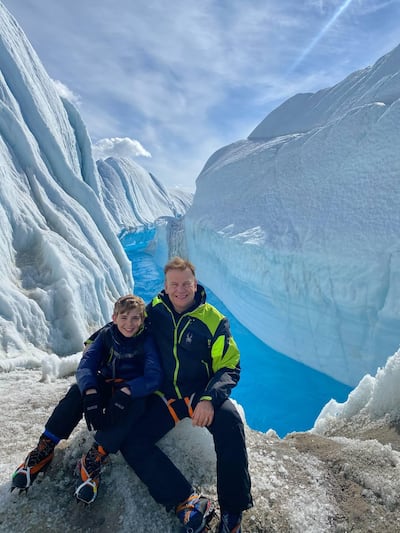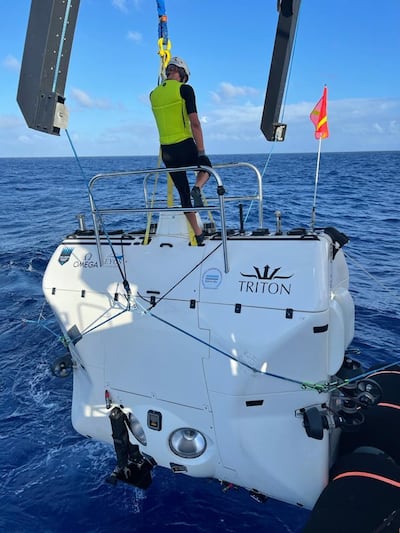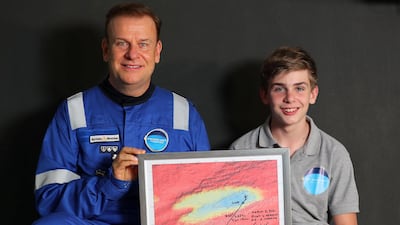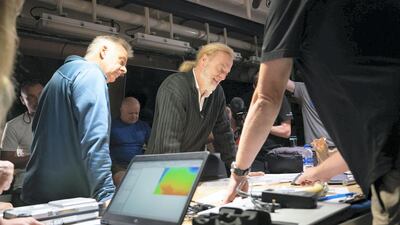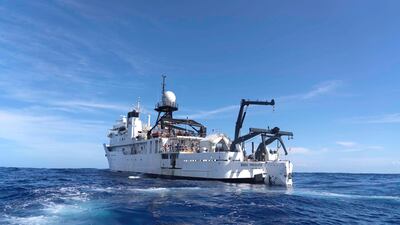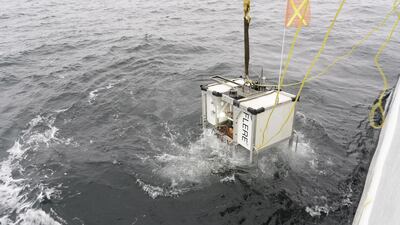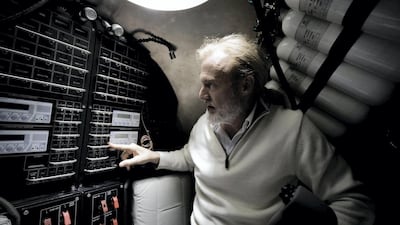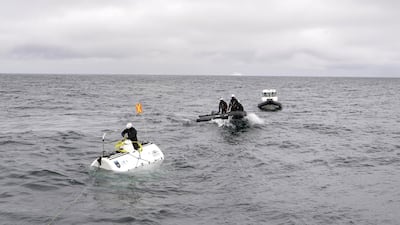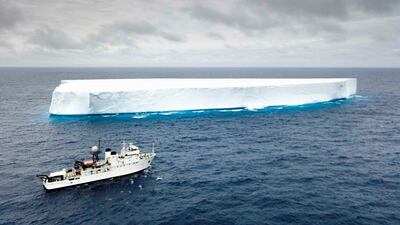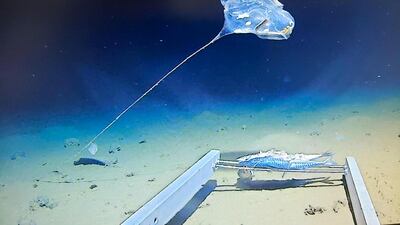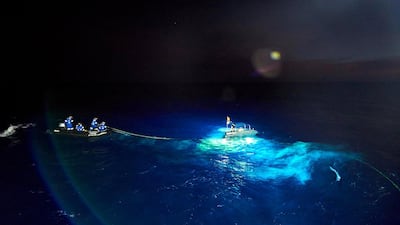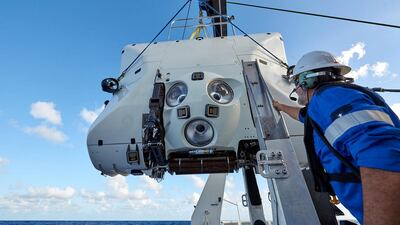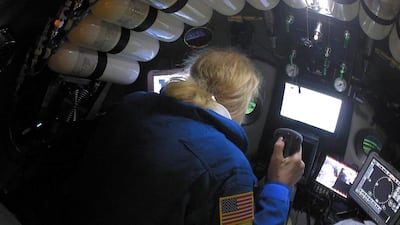A Dubai resident talked of the danger he faced during his historic journey to the bottom of the ocean.
Hamish Harding, 49, broke two world records last week on his mission to explore the depths of the Challenger Deep in the Mariana Trench in the South Pacific Ocean, which at nearly 11 kilometres is regarded as the deepest point beneath the waves.
His 12-hour mission set two Guinness World Records – the greatest distance travelled at full ocean depth and the greatest time spent at full ocean depth.
We were making a record attempt and had to go to areas that no other human being had been to before
While the expedition was a success, it did not unfold without unexpected drama that could have been taken straight from a Jules Verne novel.
“Because we were making a record attempt, we had to go to areas that no other human being had been to before,” Mr Harding said.
“We encountered jagged vertical rock faces that were very challenging to get over and we had to ascend very quickly as we didn’t want to get snagged on the rocks.
"We had to use our thrusters the entire time to climb the rock face which was about the size of Burj Khalifa. We were not expecting that at all as we expected a much flatter surface."
Mr Harding, who runs a business jet brokerage firm, was part of a two-man crew that descended to a depth that was the equivalent of about 13 Burj Khalifas.
They achieved the feat in a small submersible vessel called the Limiting Factor.
He was accompanied on the mission by Victor Vescovo, an American explorer and private investor who helped develop the vessel.
Another challenge they encountered was avoiding the debris left by previous failed expeditions.
“We had to be careful not to get snagged on the cables from other countries’ attempts to send remote-operated vehicles down there,” Mr Harding said.
“The cables were abandoned there after they had snapped.”
Scientists claimed the Mariana Trench was so deep that human bones would dissolve because of the intense pressure.
The conditions created further hurdles for Mr Harding to overcome.
“Getting electronics to work down there was a challenge,” he said.
“A cable can work perfectly a million times when tested on the surface but it’s a different story when it is subjected to such intense atmospheric pressure.
“Cables often move together when such pressure is exerted and it creates electrical shorts, which could cause something to suddenly stop.”
Mr Harding said he also discovered a new species in an environment where the atmospheric pressure was 1,200 times higher than what humans experienced on the surface.
He hopes his discovery will be of benefit to the wider scientific community.
“We found a shrimp-like creature that appears to be completely hollow,” he said.
“The reason for this is these creatures have water flowing through them at great pressure. A human head, for example, would be crushed.”
He said the creatures were being analysed by Newcastle University.
Water samples from the mission are also being scrutinised by the same scientists to see whether microplastics are present.
Mr Harding said he was already resigned to those studies finding evidence of pollution.
“The world needs to do something about pollution,” he said.
“Letting plastics get into the ocean is never going to end well.
“Microplastics are already getting into our food chain and that’s not good.”
Mr Harding said his mission was inspired by the UAE, where the UK citizen has lived since 1993.
“With the recent success of its Hope probe, the UAE has proved the impossible is possible and, as a long-term resident, I hope this achievement will in some small part contribute to the country’s reputation in science and exploration,” he said.
Mr Harding’s 13-year-old son Giles was also part of the team.
He updated people on the mission's progress with social media posts from the expedition's base of operations – a research ship previously used by the US Navy to hunt submarines.
Giles, a Dubai College pupil, had to keep to a strict schedule to balance his studies with life on board the vessel.
"I was learning remotely from 1.30pm to about 9.50pm each day," he said.
“I would go straight to bed then as you had to be up at 6am or you would miss breakfast.
“I would definitely like to go on more missions like this if it’s possible.”
Five deep ocean expeditions - in pictures
Best Academy: Ajax and Benfica
Best Agent: Jorge Mendes
Best Club : Liverpool
Best Coach: Jurgen Klopp (Liverpool)
Best Goalkeeper: Alisson Becker
Best Men’s Player: Cristiano Ronaldo
Best Partnership of the Year Award by SportBusiness: Manchester City and SAP
Best Referee: Stephanie Frappart
Best Revelation Player: Joao Felix (Atletico Madrid and Portugal)
Best Sporting Director: Andrea Berta (Atletico Madrid)
Best Women's Player: Lucy Bronze
Best Young Arab Player: Achraf Hakimi
Kooora – Best Arab Club: Al Hilal (Saudi Arabia)
Kooora – Best Arab Player: Abderrazak Hamdallah (Al-Nassr FC, Saudi Arabia)
Player Career Award: Miralem Pjanic and Ryan Giggs
Terror attacks in Paris, November 13, 2015
- At 9.16pm, three suicide attackers killed one person outside the Atade de France during a foootball match between France and Germany
- At 9.25pm, three attackers opened fire on restaurants and cafes over 20 minutes, killing 39 people
- Shortly after 9.40pm, three other attackers launched a three-hour raid on the Bataclan, in which 1,500 people had gathered to watch a rock concert. In total, 90 people were killed
- Salah Abdeslam, the only survivor of the terrorists, did not directly participate in the attacks, thought to be due to a technical glitch in his suicide vest
- He fled to Belgium and was involved in attacks on Brussels in March 2016. He is serving a life sentence in France
SPEC%20SHEET%3A%20SAMSUNG%20GALAXY%20S23%20ULTRA
%3Cp%3E%3Cstrong%3EDisplay%3A%3C%2Fstrong%3E%206.8%22%20edge%20quad-HD%2B%20dynamic%20Amoled%202X%2C%20Infinity-O%2C%203088%20x%201440%2C%20500ppi%2C%20HDR10%2B%2C%20120Hz%3C%2Fp%3E%0A%3Cp%3E%3Cstrong%3EProcessor%3A%3C%2Fstrong%3E%204nm%20Qualcomm%20Snapdragon%208%20Gen%202%2C%2064-bit%20octa-core%3C%2Fp%3E%0A%3Cp%3E%3Cstrong%3EMemory%3A%3C%2Fstrong%3E%208%2F12GB%20RAM%3C%2Fp%3E%0A%3Cp%3E%3Cstrong%3EStorage%3A%3C%2Fstrong%3E%20128%2F256%2F512GB%2F1TB%20(only%20128GB%20has%20an%208GB%20RAM%20option)%3C%2Fp%3E%0A%3Cp%3E%3Cstrong%3EPlatform%3A%3C%2Fstrong%3E%20Android%2013%3C%2Fp%3E%0A%3Cp%3E%3Cstrong%3EMain%20camera%3A%3C%2Fstrong%3E%20quad%2012MP%20ultra-wide%20f%2F2.2%20%2B%20200MP%20wide%20f%2F1.7%20%2B%2010MP%20telephoto%20f%2F4.9%20%2B%2010MP%20telephoto%202.4%3B%203x%2F10x%20optical%20zoom%2C%20Space%20Zoom%20up%20to%20100x%3B%20auto%20HDR%2C%20expert%20RAW%3C%2Fp%3E%0A%3Cp%3E%3Cstrong%3EVideo%3A%3C%2Fstrong%3E%208K%4024%2F30fps%2C%204K%4060fps%2C%20full-HD%4060fps%2C%20HD%4030fps%2C%20full-HD%20super%20slo-mo%40960fps%3C%2Fp%3E%0A%3Cp%3E%3Cstrong%3EFront%20camera%3A%3C%2Fstrong%3E%2012MP%20f%2F2.2%3C%2Fp%3E%0A%3Cp%3E%3Cstrong%3EBattery%3A%3C%2Fstrong%3E%205000mAh%2C%20fast%20wireless%20charging%202.0%2C%20Wireless%20PowerShare%3C%2Fp%3E%0A%3Cp%3E%3Cstrong%3EConnectivity%3A%3C%2Fstrong%3E%205G%2C%20Wi-Fi%2C%20Bluetooth%205.2%2C%20NFC%3C%2Fp%3E%0A%3Cp%3E%3Cstrong%3EI%2FO%3A%3C%2Fstrong%3E%20USB-C%3B%20built-in%20Galaxy%20S%20Pen%3C%2Fp%3E%0A%3Cp%3E%3Cstrong%3ESIM%3A%3C%2Fstrong%3E%20single%20nano%20%2F%20nano%20%2B%20eSIM%20%2F%20nano%20%2B%20nano%20%2B%20eSIM%20%2F%20nano%20%2B%20nano%3C%2Fp%3E%0A%3Cp%3E%3Cstrong%3EColours%3A%3C%2Fstrong%3E%20cream%2C%20green%2C%20lavender%2C%20phantom%20black%3B%20online%20exclusives%3A%20graphite%2C%20lime%2C%20red%2C%20sky%20blue%3C%2Fp%3E%0A%3Cp%3E%3Cstrong%3EPrice%3A%3C%2Fstrong%3E%20Dh4%2C949%20for%20256GB%2C%20Dh5%2C449%20for%20512GB%2C%20Dh6%2C449%20for%201TB%3B%20128GB%20unavailable%20in%20the%20UAE%3C%2Fp%3E%0A
How to apply for a drone permit
- Individuals must register on UAE Drone app or website using their UAE Pass
- Add all their personal details, including name, nationality, passport number, Emiratis ID, email and phone number
- Upload the training certificate from a centre accredited by the GCAA
- Submit their request
What are the regulations?
- Fly it within visual line of sight
- Never over populated areas
- Ensure maximum flying height of 400 feet (122 metres) above ground level is not crossed
- Users must avoid flying over restricted areas listed on the UAE Drone app
- Only fly the drone during the day, and never at night
- Should have a live feed of the drone flight
- Drones must weigh 5 kg or less
Race card
1.30pm: Handicap (PA) Dh 50,000 (Dirt) 1,400m
2pm: Handicap (TB) Dh 84,000 (D) 1,400m
2.30pm: Maiden (TB) Dh 60,000 (D) 1,200m
3pm: Conditions (TB) Dh 100,000 (D) 1.950m
3.30pm: Handicap (TB) Dh 76,000 (D) 1,800m
4pm: Maiden (TB) Dh 60,000 (D) 1,600m
4.30pm: Handicap (TB) Dh 68,000 (D) 1,000m
MATCH INFO
Serie A
Juventus v Fiorentina, Saturday, 8pm (UAE)
Match is on BeIN Sports
UAE%20athletes%20heading%20to%20Paris%202024
%3Cp%3E%3Cstrong%3EEquestrian%3C%2Fstrong%3E%3Cbr%3EAbdullah%20Humaid%20Al%20Muhairi%2C%20Abdullah%20Al%20Marri%2C%20Omar%20Al%20Marzooqi%2C%20Salem%20Al%20Suwaidi%2C%20and%20Ali%20Al%20Karbi%20(four%20to%20be%20selected).%3Cbr%3E%3Cstrong%3EJudo%3C%2Fstrong%3E%3Cbr%3EMen%3A%20Narmandakh%20Bayanmunkh%20(66kg)%2C%20Nugzari%20Tatalashvili%20(81kg)%2C%20Aram%20Grigorian%20(90kg)%2C%20Dzhafar%20Kostoev%20(100kg)%2C%20Magomedomar%20Magomedomarov%20(%2B100kg)%3B%20women's%20Khorloodoi%20Bishrelt%20(52kg).%3Cbr%3E%3Cbr%3E%3Cstrong%3ECycling%3C%2Fstrong%3E%3Cbr%3ESafia%20Al%20Sayegh%20(women's%20road%20race).%3Cbr%3E%3Cbr%3E%3Cstrong%3ESwimming%3C%2Fstrong%3E%3Cbr%3EMen%3A%20Yousef%20Rashid%20Al%20Matroushi%20(100m%20freestyle)%3B%20women%3A%20Maha%20Abdullah%20Al%20Shehi%20(200m%20freestyle).%3Cbr%3E%3Cbr%3E%3Cstrong%3EAthletics%3C%2Fstrong%3E%3Cbr%3EMaryam%20Mohammed%20Al%20Farsi%20(women's%20100%20metres).%3C%2Fp%3E%0A
Results
2pm: Maiden (PA) Dh 40,000 (Dirt) 1,200m, Winner: AF Thayer, Tadhg O’Shea (jockey), Ernst Oertel (trainer).
2.30pm: Maiden (PA) Dh 40,000 (D) 1,200m, Winner: AF Sahwa, Nathan Crosse, Mohamed Ramadan.
3pm: Handicap (PA) Dh 40,000 (D) 1,000m, Winner: AF Thobor, Szczepan Mazur, Ernst Oertel.
3.30pm: Handicap (PA) Dh 40,000 (D) 2,000m, Winner: AF Mezmar, Szczepan Mazur, Ernst Oertel.
4pm: Sheikh Hamdan bin Rashid Al Maktoum Cup presented by Longines (TB) Dh 200,000 (D) 1,700m, Winner: Galvanize, Nathan Cross, Doug Watson.
4.30pm: Handicap (PA) Dh 40,000 (D) 1,700m, Winner: Ajaj, Bernardo Pinheiro, Mohamed Daggash.
Benefits of first-time home buyers' scheme
- Priority access to new homes from participating developers
- Discounts on sales price of off-plan units
- Flexible payment plans from developers
- Mortgages with better interest rates, faster approval times and reduced fees
- DLD registration fee can be paid through banks or credit cards at zero interest rates
THE SPECS
Engine: six-litre W12 twin-turbo
Transmission: eight-speed dual clutch auto
Power: 626bhp
Torque: 900Nm
Price: Dh940,160 (plus VAT)
On sale: Q1 2020
The specs
Engine: 1.5-litre turbo
Power: 181hp
Torque: 230Nm
Transmission: 6-speed automatic
Starting price: Dh79,000
On sale: Now
Disclaimer
Director: Alfonso Cuaron
Stars: Cate Blanchett, Kevin Kline, Lesley Manville
Rating: 4/5
Abu Dhabi GP weekend schedule
Friday
First practice, 1pm
Second practice, 5pm
Saturday
Final practice, 2pm
Qualifying, 5pm
Sunday
Etihad Airways Abu Dhabi Grand Prix (55 laps), 5.10pm
Seven%20Winters%20in%20Tehran
%3Cp%3E%3Cstrong%3EDirector%20%3A%3C%2Fstrong%3E%20Steffi%20Niederzoll%3C%2Fp%3E%0A%3Cp%3E%3Cstrong%3EStarring%3A%3C%2Fstrong%3E%20Reyhaneh%20Jabbari%2C%20Shole%20Pakravan%2C%20Zar%20Amir%20Ebrahimi%3C%2Fp%3E%0A%3Cp%3E%3Cstrong%3ERating%3A%3C%2Fstrong%3E%204%2F5%3C%2Fp%3E%0A
Meydan race card
6.30pm: Maiden Dh 165,000 1,600m
7.05pm: Handicap Dh 185,000 2,000m
7.40pm: Maiden Dh 165,000 1,600m
8.15pm: Handicap Dh 190,000 1,400m
8.50pm: Handicap Dh 175,000 1,600m
9.25pm: Handicap Dh 175,000 1,200m
10pm: Handicap Dh 165,000 1,600m
OPINIONS ON PALESTINE & ISRAEL
Timeline
2012-2015
The company offers payments/bribes to win key contracts in the Middle East
May 2017
The UK SFO officially opens investigation into Petrofac’s use of agents, corruption, and potential bribery to secure contracts
September 2021
Petrofac pleads guilty to seven counts of failing to prevent bribery under the UK Bribery Act
October 2021
Court fines Petrofac £77 million for bribery. Former executive receives a two-year suspended sentence
December 2024
Petrofac enters into comprehensive restructuring to strengthen the financial position of the group
May 2025
The High Court of England and Wales approves the company’s restructuring plan
July 2025
The Court of Appeal issues a judgment challenging parts of the restructuring plan
August 2025
Petrofac issues a business update to execute the restructuring and confirms it will appeal the Court of Appeal decision
October 2025
Petrofac loses a major TenneT offshore wind contract worth €13 billion. Holding company files for administration in the UK. Petrofac delisted from the London Stock Exchange
November 2025
180 Petrofac employees laid off in the UAE
Dubai Bling season three
Cast: Loujain Adada, Zeina Khoury, Farhana Bodi, Ebraheem Al Samadi, Mona Kattan, and couples Safa & Fahad Siddiqui and DJ Bliss & Danya Mohammed
Rating: 1/5
Bharat
Director: Ali Abbas Zafar
Starring: Salman Khan, Katrina Kaif, Sunil Grover
Rating: 2.5 out of 5 stars
Mohammed bin Zayed Majlis
High profile Al Shabab attacks
- 2010: A restaurant attack in Kampala Uganda kills 74 people watching a Fifa World Cup final football match.
- 2013: The Westgate shopping mall attack, 62 civilians, five Kenyan soldiers and four gunmen are killed.
- 2014: A series of bombings and shootings across Kenya sees scores of civilians killed.
- 2015: Four gunmen attack Garissa University College in northeastern Kenya and take over 700 students hostage, killing those who identified as Christian; 148 die and 79 more are injured.
- 2016: An attack on a Kenyan military base in El Adde Somalia kills 180 soldiers.
- 2017: A suicide truck bombing outside the Safari Hotel in Mogadishu kills 587 people and destroys several city blocks, making it the deadliest attack by the group and the worst in Somalia’s history.
If you go
Flight connections to Ulaanbaatar are available through a variety of hubs, including Seoul and Beijing, with airlines including Mongolian Airlines and Korean Air. While some nationalities, such as Americans, don’t need a tourist visa for Mongolia, others, including UAE citizens, can obtain a visa on arrival, while others including UK citizens, need to obtain a visa in advance. Contact the Mongolian Embassy in the UAE for more information.
Nomadic Road offers expedition-style trips to Mongolia in January and August, and other destinations during most other months. Its nine-day August 2020 Mongolia trip will cost from $5,250 per person based on two sharing, including airport transfers, two nights’ hotel accommodation in Ulaanbaatar, vehicle rental, fuel, third party vehicle liability insurance, the services of a guide and support team, accommodation, food and entrance fees; nomadicroad.com
A fully guided three-day, two-night itinerary at Three Camel Lodge costs from $2,420 per person based on two sharing, including airport transfers, accommodation, meals and excursions including the Yol Valley and Flaming Cliffs. A return internal flight from Ulaanbaatar to Dalanzadgad costs $300 per person and the flight takes 90 minutes each way; threecamellodge.com
The specs
- Engine: 3.9-litre twin-turbo V8
- Power: 640hp
- Torque: 760nm
- On sale: 2026
- Price: Not announced yet
Specs
Engine: 51.5kW electric motor
Range: 400km
Power: 134bhp
Torque: 175Nm
Price: From Dh98,800
Available: Now
Ferrari 12Cilindri specs
Engine: naturally aspirated 6.5-liter V12
Power: 819hp
Torque: 678Nm at 7,250rpm
Price: From Dh1,700,000
Available: Now
Sweet%20Tooth
%3Cp%3E%3Cstrong%3ECreator%3A%20%3C%2Fstrong%3EJim%20Mickle%3Cbr%3E%3Cstrong%3EStarring%3A%20%3C%2Fstrong%3EChristian%20Convery%2C%20Nonso%20Anozie%2C%20Adeel%20Akhtar%2C%20Stefania%20LaVie%20Owen%3Cbr%3E%3Cstrong%3ERating%3A%20%3C%2Fstrong%3E2.5%2F5%3C%2Fp%3E%0A
Korean Film Festival 2019 line-up
Innocent Witness, June 26 at 7pm
On Your Wedding Day, June 27 at 7pm
The Great Battle, June 27 at 9pm
The Witch: Part 1. The Subversion, June 28 at 4pm
Romang, June 28 at 6pm
Mal Mo E: The Secret Mission, June 28 at 8pm
Underdog, June 29 at 2pm
Nearby Sky, June 29 at 4pm
A Resistance, June 29 at 6pm
The specs: 2018 Harley-Davidson Fat Boy
Price, base / as tested Dh97,600
Engine 1,745cc Milwaukee-Eight v-twin engine
Transmission Six-speed gearbox
Power 78hp @ 5,250rpm
Torque 145Nm @ 3,000rpm
Fuel economy, combined 5.0L / 100km (estimate)
BEETLEJUICE BEETLEJUICE
Starring: Winona Ryder, Michael Keaton, Jenny Ortega
Director: Tim Burton
Rating: 3/5
10 tips for entry-level job seekers
- Have an up-to-date, professional LinkedIn profile. If you don’t have a LinkedIn account, set one up today. Avoid poor-quality profile pictures with distracting backgrounds. Include a professional summary and begin to grow your network.
- Keep track of the job trends in your sector through the news. Apply for job alerts at your dream organisations and the types of jobs you want – LinkedIn uses AI to share similar relevant jobs based on your selections.
- Double check that you’ve highlighted relevant skills on your resume and LinkedIn profile.
- For most entry-level jobs, your resume will first be filtered by an applicant tracking system for keywords. Look closely at the description of the job you are applying for and mirror the language as much as possible (while being honest and accurate about your skills and experience).
- Keep your CV professional and in a simple format – make sure you tailor your cover letter and application to the company and role.
- Go online and look for details on job specifications for your target position. Make a list of skills required and set yourself some learning goals to tick off all the necessary skills one by one.
- Don’t be afraid to reach outside your immediate friends and family to other acquaintances and let them know you are looking for new opportunities.
- Make sure you’ve set your LinkedIn profile to signal that you are “open to opportunities”. Also be sure to use LinkedIn to search for people who are still actively hiring by searching for those that have the headline “I’m hiring” or “We’re hiring” in their profile.
- Prepare for online interviews using mock interview tools. Even before landing interviews, it can be useful to start practising.
- Be professional and patient. Always be professional with whoever you are interacting with throughout your search process, this will be remembered. You need to be patient, dedicated and not give up on your search. Candidates need to make sure they are following up appropriately for roles they have applied.
Arda Atalay, head of Mena private sector at LinkedIn Talent Solutions, Rudy Bier, managing partner of Kinetic Business Solutions and Ben Kinerman Daltrey, co-founder of KinFitz
Biggest%20applause
%3Cp%3EAsked%20to%20rate%20Boris%20Johnson's%20leadership%20out%20of%2010%2C%20Mr%20Sunak%20awarded%20a%20full%2010%20for%20delivering%20Brexit%20%E2%80%94%20remarks%20that%20earned%20him%20his%20biggest%20round%20of%20applause%20of%20the%20night.%20%22My%20views%20are%20clear%2C%20when%20he%20was%20great%20he%20was%20great%20and%20it%20got%20to%20a%20point%20where%20we%20need%20to%20move%20forward.%20In%20delivering%20a%20solution%20to%20Brexit%20and%20winning%20an%20election%20that's%20a%2010%2F10%20-%20you've%20got%20to%20give%20the%20guy%20credit%20for%20that%2C%20no-one%20else%20could%20probably%20have%20done%20that.%22%3C%2Fp%3E%0A
How to help
Send “thenational” to the following numbers or call the hotline on: 0502955999
2289 – Dh10
2252 – Dh 50
6025 – Dh20
6027 – Dh 100
6026 – Dh 200
Killing of Qassem Suleimani
More on Quran memorisation:
NBA Finals results
Game 1: Warriors 124, Cavaliers 114
Game 2: Warriors 122, Cavaliers 103
Game 3: Cavaliers 102, Warriors 110
Game 4: In Cleveland, Sunday (Monday morning UAE)
Our legal columnist
Name: Yousef Al Bahar
Advocate at Al Bahar & Associate Advocates and Legal Consultants, established in 1994
Education: Mr Al Bahar was born in 1979 and graduated in 2008 from the Judicial Institute. He took after his father, who was one of the first Emirati lawyers
The%20specs%20
%3Cp%3E%3Cstrong%3EEngine%3A%20%3C%2Fstrong%3EDual%20permanently%20excited%20synchronous%20motors%3Cbr%3E%3Cstrong%3EPower%3A%20%3C%2Fstrong%3E516hp%20or%20400Kw%3Cbr%3E%3Cstrong%3ETorque%3A%20%3C%2Fstrong%3E858Nm%3Cbr%3E%3Cstrong%3ETransmission%3A%20%3C%2Fstrong%3ESingle%20speed%20auto%3Cbr%3E%3Cstrong%3ERange%3A%20%3C%2Fstrong%3E485km%3Cbr%3E%3Cstrong%3EPrice%3A%20%3C%2Fstrong%3EFrom%20Dh699%2C000%3C%2Fp%3E%0A
%3Cp%3EThe%20Department%20of%20Culture%20and%20Tourism%20-%20Abu%20Dhabi%E2%80%99s%20Arabic%20Language%20Centre%20will%20mark%20International%20Women%E2%80%99s%20Day%20at%20the%20Bologna%20Children's%20Book%20Fair%20with%20the%20Abu%20Dhabi%20Translation%20Conference.%20Prolific%20Emirati%20author%20Noora%20Al%20Shammari%2C%20who%20has%20written%20eight%20books%20that%20%20feature%20in%20the%20Ministry%20of%20Education's%20curriculum%2C%20will%20appear%20in%20a%20session%20on%20Wednesday%20to%20discuss%20the%20challenges%20women%20face%20in%20getting%20their%20works%20translated.%3C%2Fp%3E%0A
